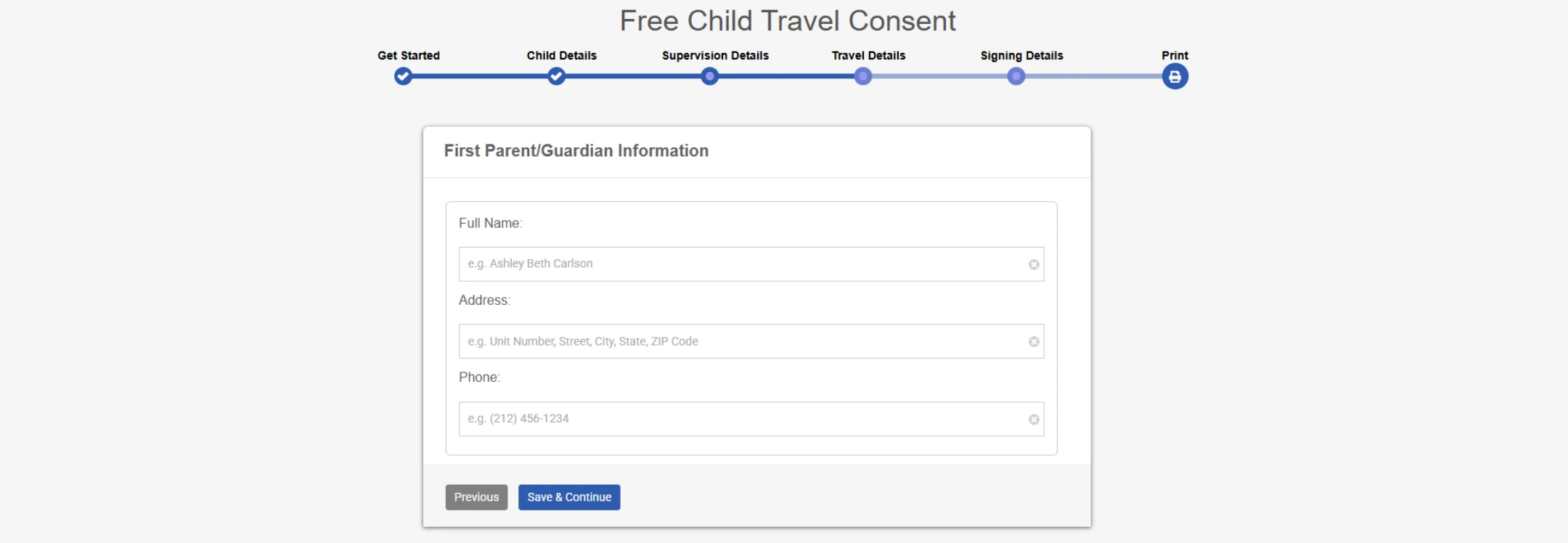Last Updated: October 18, 2025
TL;DR
- A child travel consent form is essential when a minor travels without one or both legal guardians, especially for international trips.
- The form must include key details like travel dates, destinations, guardian permissions, and emergency contact information.
- Airlines, border agents, and immigration officials may deny boarding or entry if minor children travel without proper documentation.
- It’s recommended to notarize the document to ensure legal acceptance and reduce travel disruptions.
- To make things easier, the blog shows how you can create a legally valid child travel consent form using Ziji Legal Forms.
Introduction
Planning a family trip involves numerous considerations, from booking flights to packing essentials. However, when children travel without both parents or legal guardians present, an additional crucial document comes into play: the child travel consent form. This legal document serves as written authorization allowing a minor to travel domestically or internationally when not accompanied by all their legal guardians.The importance of child travel consent forms has grown significantly in recent years due to heightened security measures at airports, stricter border controls, and increased airline policies designed to prevent child abduction and trafficking . Immigration authorities, customs officials, and airline personnel may request this documentation to verify that children have proper permission to travel.
Understanding when and how to properly prepare a child travel consent form can mean the difference between a smooth journey and unexpected delays, denied boarding, or legal complications at international borders. This comprehensive guide will help parents, guardians, and caregivers navigate the complexities of child travel documentation, ensuring safe and hassle-free travel experiences for families.
Key Terms You Need to Know
Minor or Child
A minor child is defined as an individual who has not attained 18 years of age, or has not attained 19 years of age and is a full-time student in a secondary school. However, some countries may have different age definitions, with some considering anyone under 19 years old as requiring consent documentation.
Parent or Guardian
Individuals who hold legal custody, parental responsibility, or decision-making authority for the child. This includes biological parents, adoptive parents, and court-appointed legal guardians who have the right to make major decisions about the child's welfare and travel.
Accompanying Adult
The person who will be traveling with or supervising the child during the trip. This could be a single parent, relative, family friend, teacher, or organization representative responsible for the child's care during travel.
Consent Form or Authorization Letter
A legal document that provides written permission from non-traveling parents or guardians for a child to travel. This document demonstrates that all parties with parental authority are aware of and approve the travel arrangements.
Notarization
The process by which a certified notary public verifies the identities of the document signers and witnesses their signatures. Notarization adds legal authenticity to the document and increases its acceptance by authorities.
Custody Agreement
Legal documentation that outlines which parent or guardian has decision-making authority over the child. These agreements may specify travel restrictions or requirements that affect consent form preparation.

What Is a Child Travel Consent Form?
A child travel consent form is a legal document that grants permission for a minor to travel without one or both of their legal parents or guardians. This written authorization serves as proof that the child has explicit permission from their non-traveling parent or guardian to embark on the planned journey.
The form differs significantly from other family law documents such as custody agreements or adoption papers.
While custody agreements establish long-term parental rights and responsibilities, a travel consent form provides specific, temporary authorization for a particular trip. Unlike permanent legal documents, travel consent forms are typically valid only for the specific dates, destinations, and circumstances outlined in the document.
Child travel consent forms cover various types of travel scenarios, including domestic trips within the United States and international journeys to foreign countries. The document applies whether a child is traveling with one parent while the other remains at home, journeying with grandparents or other relatives, participating in school trips or sports team travel, or even traveling alone through unaccompanied minor programs offered by airlines
The legal weight of these documents has increased substantially as governments and transportation authorities have implemented stricter measures to combat child trafficking and prevent parental abduction. Border control agents and immigration officers are specifically trained to identify potential trafficking situations, making proper documentation essential for legitimate family travel.
When Do You Need a Child Travel Consent Form?
Understanding when a child travel consent form is required can prevent travel disruptions and ensure compliance with various authorities' requirements. The need for these forms extends beyond international travel and applies to numerous domestic situations as well.
International Travel Scenarios
Any time a child travels internationally without both parents present, a consent form is strongly recommended and often required. This includes situations where one parent accompanies the child while the other remains at home, when children travel with grandparents or other relatives for vacation, and when minors participate in student exchange programs or international school trips.
Domestic Travel Requirements
While domestic travel within the United States generally does not legally require consent forms, many situations benefit from having this documentation. Children traveling alone on domestic flights, particularly those participating in unaccompanied minor programs, often need consent forms. Additionally, some domestic travel crossing state lines or involving rental cars may require proof of parental permission.
Single Parent Travel
When divorced or separated parents travel with their children, having a consent letter from the non-traveling parent can prevent complications at borders and airports. Even married parents may find consent forms helpful when one spouse travels alone with children, particularly for international destinations.
Group Travel and School Trips
Educational institutions organizing field trips, sports teams traveling to competitions, and religious or cultural organizations planning group travel typically require parental consent forms. These forms often include additional authorizations for medical treatment and emergency care during the trip.
Unaccompanied Minor Travel
Airlines have specific policies for children traveling alone, with most requiring consent documentation for minors under certain ages. Age requirements vary by airline, but generally apply to children between 5 and 14 years old, with some extending requirements to age 17 for international travel.
Why Is a Child Travel Consent Form Important?
The significance of child travel consent forms extends far beyond simple paperwork requirements, serving multiple critical functions in modern travel security and child protection.
Legal Protection Against Abduction Accusations
One of the primary purposes of consent forms is to provide legal protection against false accusations of child abduction or custodial interference. When a child travels with only one parent or a non-parent adult, authorities may question the legitimacy of the travel arrangement. A properly executed consent form provides immediate proof that the child has permission to travel, protecting both the child and the accompanying adult from unnecessary legal complications.
Smooth Passage Through Security and Borders
Immigration authorities, customs officials, and airport security personnel are trained to identify potential child trafficking situations. Having proper consent documentation facilitates smooth passage through these checkpoints and reduces the likelihood of delays, secondary screening, or detention. Border agents can quickly verify that the child has proper authorization to travel, expediting the immigration process for legitimate travelers.
Airline and Transportation Requirements
Many airlines have implemented policies requiring consent documentation for minors traveling without both parents. These policies help airlines comply with international regulations and provide additional protection for children in their care. Cruise lines and other transportation companies may have similar requirements, particularly for international journeys.
Emergency Situations and Medical Authorization
Travel consent forms often include provisions for emergency medical treatment, allowing accompanying adults to make necessary medical decisions if parents cannot be reached. This authorization can be crucial in situations requiring immediate medical attention, ensuring that children receive prompt care without delays caused by the need to contact distant parents.
Peace of Mind for All Parties
Beyond legal requirements, consent forms provide psychological comfort for parents, children, and accompanying adults. Parents can travel or remain at home knowing they have provided proper authorization, children understand they have permission for their journey, and accompanying adults have legal backing for their responsibility.
Key Components of a Child Travel Consent Form
A comprehensive child travel consent form must include specific information to ensure legal validity and acceptance by authorities. Understanding these essential components helps parents create effective documentation that will be recognized and accepted across different jurisdictions.
Complete Child Information
The form must include the child's full legal name exactly as it appears on their passport or government-issued identification. Additional required information includes the child's date of birth, place of birth, current address, and passport number if applicable. Some forms also request the child's physical description or other identifying characteristics to prevent document misuse.
Detailed Parent or Guardian Information
All parents or legal guardians with decision-making authority must be clearly identified in the document. This includes full legal names, current addresses, phone numbers, email addresses, and their legal relationship to the child. If parents are divorced or separated, the form should reference any relevant custody arrangements or court orders.
Comprehensive Travel Details
The consent form must specify exact travel dates, including departure and return dates. Destination information should include specific cities and countries to be visited, with addresses where the child will be staying if known. The purpose of travel should be clearly stated, whether for vacation, education, family visits, or other reasons.
Accompanying Adult Information
If the child will be traveling with someone other than a parent, complete information about the accompanying adult is essential. This includes the person's full name, relationship to the child, contact information, and passport details if traveling internationally. For group travel, the organization's name and supervising adult information should be included.
Clear Authorization Statement
The heart of the document is a clear, unambiguous statement of permission from the non-traveling parent or guardian. This statement should explicitly authorize the child to travel and may include specific permissions for activities, extended stays, or emergency situations.
Notarization and Witnessing
While not always legally required, notarization significantly increases the document's acceptance and validity. The notarization process involves a certified notary public verifying the identity of the signing parent and witnessing their signature. Some jurisdictions or situations may require additional witnesses beyond notarization.
Emergency Contact Information
The form should include comprehensive emergency contact information for parents or guardians. This typically includes multiple phone numbers, email addresses, and alternative contacts who can make decisions if primary contacts are unavailable.
Medical Consent Provisions
Many travel consent forms include authorization for emergency medical treatment. This section may specify any medical conditions, allergies, current medications, and insurance information relevant to the child's care. Some forms also include specific restrictions on certain types of medical treatment based on religious or personal beliefs.
What Happens If You Don't Have a Child Travel Consent Form?
The absence of proper travel consent documentation can result in significant complications ranging from minor delays to serious legal issues. Understanding these potential consequences emphasizes the importance of proper preparation before travel.
Airport and Border Delays
Immigration officers and customs officials have the authority to detain travelers for additional questioning when proper documentation is missing. These delays can last several hours while authorities attempt to verify the legitimacy of travel arrangements and contact non-traveling parents for permission. During peak travel periods, such delays can cause missed connections and disrupted travel plans.
Denied Boarding or Entry
Airlines may refuse to allow children to board flights without proper consent documentation, particularly for international destinations. Similarly, immigration authorities at destination countries can deny entry to minors who lack adequate travel authorization. These situations often result in expensive rebooking fees, extended hotel stays, and significant disruption to travel plans.
Legal Complications in Custody Disputes
When parents are involved in custody disputes or divorce proceedings, traveling without proper consent can trigger legal action by the non-traveling parent. Courts may view unauthorized travel as a violation of custody agreements or even attempted parental abduction. These situations can result in emergency court orders, involvement of law enforcement, and serious legal consequences for the traveling parent.
Child Welfare Interventions
In extreme cases, authorities may temporarily separate children from accompanying adults while investigating potential abduction or trafficking situations. Child protective services may become involved if officials suspect the child is being transported without proper parental permission. These interventions, while designed to protect children, can be traumatic and disruptive even when the travel is legitimate.
Financial and Emotional Costs
Beyond the immediate travel disruption, lacking proper documentation can result in significant financial costs including rebooking fees, extended accommodation expenses, and potential legal fees. The emotional toll on children and families can be substantial, particularly when travel involves important events like family reunions or medical treatment.
How to Create a Legally Sound Child Travel Consent Form
Creating an effective travel consent form requires attention to legal details and awareness of varying requirements across different jurisdictions. While generic online templates may provide a starting point, properly crafted forms require careful consideration of specific travel circumstances and legal requirements.
Understanding Jurisdictional Variations
Requirements for travel consent forms vary significantly between countries and even between states within the United States. Some countries require specific language or additional documentation, while others may have different notarization requirements. International travelers should research the specific requirements of their destination country before finalizing their consent form.
Avoiding Generic Online Templates
While free templates are widely available online, they often lack the specificity and legal precision required for effective travel documentation. Generic forms may not include jurisdiction-specific requirements or may contain outdated information that could cause problems at borders. Additionally, these templates may not address complex family situations such as custody disputes or special medical needs.
Ensuring Complete and Accurate Information
The effectiveness of a travel consent form depends entirely on the accuracy and completeness of the information it contains. Any discrepancies between the form and official documents like passports or birth certificates can raise suspicions and cause delays. Parents should verify all information multiple times and ensure that names are spelled exactly as they appear on official identification documents.
Professional Legal Forms Platforms
Using established legal forms platforms ensures access to current, jurisdiction-specific templates that meet legal requirements. These platforms typically update their forms regularly to reflect changing laws and requirements, providing users with current and accurate documentation. Professional platforms also offer guidance on completing forms correctly and may provide additional resources for complex situations.
Multiple Language Considerations
For international travel, consider having consent forms translated into the language of the destination country. While English forms are widely accepted, having documentation in the local language can facilitate faster processing and reduce misunderstandings. Some countries specifically require translations or may provide their own preferred consent form formats.
Using Ziji Legal Forms for Your Child Travel Consent Form
Creating a legally compliant child travel consent form is straightforward with Ziji Legal Forms. The platform is designed for ease of use and ensures that all legal requirements are met, providing peace of mind for families preparing to travel with minors.
Step 1 - Select the Right Template
Log in to Ziji Legal Forms and choose the child travel consent form template.
Step 2 - Enter Child Information
Fill in the child’s full details, including name, date of birth, and any required identification information.

Step 3 - Add Travel Itinerary
Specify the travel dates, and destinations planned for the trip.
Step 4 - Provide Accompanying Adult Details
Enter the name, relationship, and contact information for the adult who will travel with the child.

Step 5 - Include Emergency Contact Information
List emergency contacts and their phone numbers so authorities can reach them if needed.
Step 6 - Review and Download the Form
Review the completed form and download it in a printable format for notarization or travel use.

Tips for Traveling with a Child Travel Consent Form
Proper preparation and handling of travel consent forms can significantly improve the travel experience and prevent complications during the journey. Following established best practices ensures that documentation is readily available when needed and accepted by authorities.
Maintain Multiple Copies
Always prepare several copies of notarized consent forms before traveling. Keep copies in different locations including carry-on luggage, checked baggage, and with the traveling adult. Consider leaving additional copies with family members at home who can provide them if needed. Digital copies stored securely online can serve as backups if physical copies are lost or damaged.
Notarization Best Practices
Whenever possible, have consent forms notarized by a licensed notary public. Notarized documents carry greater legal weight and are more likely to be accepted without question by authorities. For urgent situations, remote online notarization services are available in many jurisdictions, allowing parents to complete the notarization process digitally.
Accessibility During Travel
Keep consent forms easily accessible throughout the journey, not packed away in checked luggage. Border officials, airline personnel, and other authorities may request documentation at various points during travel. Having forms readily available prevents delays and demonstrates preparedness to officials.
School and Organization Coordination
When children travel with schools, sports teams, or other organizations, coordinate with trip organizers to ensure all necessary documentation is provided. Some organizations prefer to collect all consent forms centrally, while others require parents to provide forms directly to accompanying adults.
International Travel Preparation
For international destinations, research specific entry requirements for the destination country well in advance of travel. Some countries have unique documentation requirements or preferred consent form formats. Contact the destination country's embassy or consulate for current requirements and any recent changes to entry procedures.
Additional Documents You May Need
While the travel consent form serves as the primary authorization document, several supporting documents may be required or recommended depending on the travel circumstances.
Birth Certificates and Relationship Proof
Original or certified copies of the child's birth certificate help establish the relationship between parent and child, particularly important when surnames differ. For adopted children, adoption certificates serve the same purpose and should be carried along with travel consent forms. These documents are especially important for international travel where officials may question family relationships.
Custody Documentation
Parents who are divorced or separated should carry copies of relevant custody agreements or court orders. These documents clarify which parent has the authority to grant travel permission and can prevent complications if questions arise about parental rights. If one parent has sole custody, documentation of this arrangement should accompany the child during travel.
Medical Insurance and Health Information
Carry copies of the child's health insurance cards and any relevant medical information. For children with chronic medical conditions, detailed medical information and current medication lists should be provided to accompanying adults. Emergency medical contact information for the child's regular physicians can be valuable if medical situations arise during travel.
Passport and Identification Documents
Ensure all identification documents are current and will remain valid throughout the travel period. For international travel, passports should have at least six months of validity remaining, as required by many countries. Keep copies of all identification documents separate from originals in case of loss or theft.
Death Certificates
In situations where one parent is deceased, carrying a certified copy of the death certificate can prevent complications when the surviving parent travels alone with children. This documentation explains why only one parent is providing consent and can prevent delays or questions from officials.
Conclusion
Child travel consent forms represent a critical component of modern family travel planning, serving as essential protection for children, parents, and accompanying adults in an increasingly security-conscious world. These documents provide legal authorization for minors to travel when not accompanied by all their parents or legal guardians, helping prevent complications at borders, airports, and other checkpoints while demonstrating compliance with international child protection measures.
The importance of proper preparation cannot be overstated, as the absence of adequate documentation can result in denied boarding, entry refusal, significant delays, and even legal complications. Understanding when consent forms are required, what information they must contain, and how to prepare them properly ensures that families can focus on enjoying their travel experiences rather than dealing with preventable bureaucratic obstacles.
Modern solutions like digital notarization and professional legal forms platforms like Ziji Legal Forms have simplified the process of creating legally compliant travel consent forms while ensuring they meet current requirements across different jurisdictions. By taking the time to prepare proper documentation in advance, families can travel with confidence knowing they have taken appropriate steps to protect their children and facilitate smooth passage through all stages of their journey.
Whether planning a domestic family vacation, an international educational trip, or sending children to visit relatives, investing in proper travel consent documentation through trusted platforms like Ziji Legal Forms provides peace of mind and legal protection that makes the preparation effort worthwhile.
Child Travel Consent Forms FAQs
What is a child travel consent form?
A legal document authorizing a minor to travel without one or both legal guardians, either alone or with another adult.
Who needs a child travel consent form?
Any minor under 18 traveling domestically or internationally without one or both legal guardians including school trips, vacations with extended family, or traveling alone.
Why is a child travel consent form important?
It helps prevent delays or denial of travel by proving the child has parental or legal guardian permission, especially important due to child abduction concerns.
Does the form need to be notarized?
While not legally required in all jurisdictions, notarizing the form is highly recommended for stronger legal validity and smoother travel clearance.
What other names is this form known by?
It may also be referred to as a travel authorization letter, travel consent letter, or consent letter for travel.
What jurisdictions can use our child travel consent form?
You can use our template to create a legal and valid child travel consent form for the following jurisdictions:
| Alabama (AL) | Alaska (AK) | Arizona (AZ) | Arkansas (AR) | California (CA) |
| Colorado (CO) | Connecticut (CT) | Delaware (DE) | District of Columbia (DC) | Florida (FL) |
| Georgia (GA) | Hawaii (HI) | Idaho (ID) | Illinois (IL) | Indiana (IN) |
| Iowa (IA) | Kansas (KS) | Kentucky (KY) | Louisiana (LA) | Maine (ME) |
| Maryland (MD) | Massachusetts (MA) | Michigan (MI) | Minnesota (MN) | Mississippi (MS) |
| Missouri (MO) | Montana (MT) | Nebraska (NE) | Nevada (NV) | New Hampshire (NH) |
| New Jersey (NJ) | New Mexico (NM) | New York (NY) | North Carolina (NC) | North Dakota (ND) |
| Ohio (OH) | Oklahoma (OK) | Oregon (OR) | Pennsylvania (PA) | Rhode Island (RI) |
| South Carolina (SC) | South Dakota (SD) | Tennessee (TN) | Texas (TX) | Utah (UT) |
| Vermont (VT) | Virginia (VA) | Washington (WA) | West Virginia (WV) | Wisconsin (WI) |
| Wyoming (WY) |

